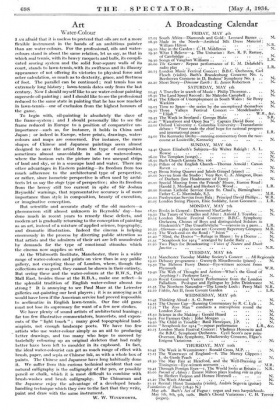Art
Water-Colour
1 AM afraid that it is useless to pretend that oils are not a more flexible instrument in the hands of an ambitious painter than are water-colours. For the professional, oils and water- colours stand in about the same relation, let us say, as that in which real tennis, with its heavy racquets and balls, its compli- cated scoring system and the solid four-square walls of its court, stands to lawn-tennis, with its swiftness and its illusory appearance of not offering its victories to physical force and sober calculation, so much as to dexterity, grace, and fleetness of foot. The parallel can be continued ; real tennis has an extremely long history ; lawn-tennis dates only from the last century. Now I should myself like to see water-colour painting supersede oil-painting ; and I should like to see the professional reduced to the same state in painting that he has now reached in lawn-tennis--one of exclusion from the highest honours of the game.
To begin with, oil-painting is absolutely the slave of the frame-system: and I should personally like to see the frame reduced in Europe to a position of comparative un- importance-such as, for instance, it holds in China and Japan ; or indeed in Europe, where prints, drawings, water- colours and maps are concerned. For instance, the mere shapes of Chinese and Japanese paintings seem almost designed to save the artist from the type of composition sometimes almost unavoidable in oils or water-colours, where the horizon cuts the picture into two unequal strips of land and sky, or in a seascape land and water. There are other advantages in Eastern painting-its freedom from too much adherence to the architectural type of perspective, or rather, since isometric perspective is often used by archi- tects let us say the stage type of perspective ; also its freedom from the heresy still too current in spite of Sir Joshua Reynolds' warnings, that representative accuracy is of more importance than style in composition, beauty of execution, or imaginative conception.
But scientific and accurate study of the old masters-a phenomenon still almost unknown in Reynolds' day-has done much in recent years to remedy these defects, and modern art is gradually returning to the conception of painting as an art, instead of a mixture of applied science, topography, and dramatic illustration. Indeed the cinema is helping enormously in the process by diverting public attention so that artists and the admirers of their art are left unmolested by demands for the type of emotional stimulus which the cinema now supplies so well.
At the Whitworth Institute, Manchester, there is a wider range of water-colours and prints-on view than in any public gallery, not excepting those of London, where, though the collections are as good, they cannot be shown in their entirety. But seeing these and the water-colours at the R.W.S., Pall Mall East, besides those at the R.B.A., make one reflect-is the splendid tradition of English water-colour almost too strong ? It is annoying to see Paul Maze at the Leicester galleries out-painting our best players ; it is as annoying as it would have been if the American service had proved impossible to acclimatize in English lawn-tennis. Our fine old game must not lose its supremacy for want of a few new strokes.
• We have plenty of sound artists of architectural leanings ; far too few illustrative commentators, humorists, and expon- ents of the "light touch " ; many good topographical land- scapists, not enough landscape poets. We have too few artists who use water-colour simply as an aid to producing better drawings, and too many who hope to succeed by tastefully colouring up an original skeleton that had really better 'have been left to moulder in its cupboard. In fact, the ideal water-colourist can get as much range of effect with brush, paper, and sepia or Chinese ink, as with a whole box of paints. The Chinese and Japanese have long habitually done it. We suffer from this curious technical accident that our natural calligraphy is the calligraphy of the pen, or possibly pencil or chalk, which it is most difficult to combine with brush-washes and brush calligraphy. The Chinaman and the Japanese enjoy the advantage of a developed brush- handling technique which they owe to the fact that they write, paint and draw with the same instrument. W. W. WINKWORTIL












































 Previous page
Previous page